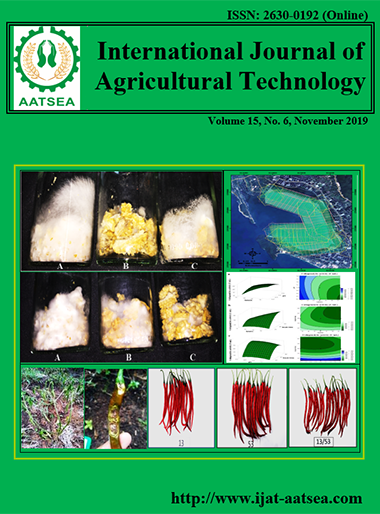Superiority test of mixed-cropping models for chili pepper hybrid varieties through participatory plant breeding
Main Article Content
Abstract
Mixed cropping system is reported to increase chili pepper productivity by suppressing insect and pathogen developments. Participatory plant breeding might produce desired variety and combination of hybrid varieties. The superior model for mixed cropping for chili pepper variety, insect and disease resistances is designed as preferred by consumers. Results showed that the best mixed cropping for chili pepper hybrids was UNIB CH13 and Dwiguna UNIB. This combination produced total fruit weight of 300.12 g per-plant, longest fruit length of 13.66 cm, fruit stalk of 5.43 cm, canopy area of 3172.53 cm2, biggest stem diameter of 11.79 mm and highest fruit weight of 5117.22 g per-plot. Mixed cropping of UNIB CH13 and Dwiguna UNIB had the lowest disease incidence caused by Cercospora sp. Infested by Colletotrichum, Fusarium and Begomovirus on chili peppers plants were not significantly different. Although growers prefered to select monocropping of UNIB CH13 and Dwiguna UNIB, but growers chose the combination of UNIB CH13 and Dwiguna UNIB for fruit shape and homogeneity.
Article Details

This work is licensed under a Creative Commons Attribution-NonCommercial-NoDerivatives 4.0 International License.
References
Adiyoga, W. (2012). Preferensi konsumen dan upaya mendukung daya saing sayuran. Retrived from http://www.litbang.pertanian.go.id/buku/.
Adriani, A., Rahman., Gusnawati, H. S. and Khaeruni, A. (2012). Respon ketahanan berbagai varietas tomat terhadap penyakit layu bakteri (Ralstonia solanacearum). Jurnal Agroteknos 2:63-68. [text in Indonesian Language].
Anonymous (2014). Statistik ekspor impor komoditas pertanian 2001-2013. Jurnal Statistik Ekspor Impor Komoditas Pertanian, pp:5-8. [text in Indonesian Language].
Badan Pusat Statistik (2019). Rata-Rata Konsumsi per Kapita Seminggu Beberapa Macam Bahan Makanan Penting, 2007-2018. Retrieved from https://www.bps.go.id/.
Badan Standardisasi Nasional (1998). Standar nasional indonesia cabai merah segar, SNI. No.01-448-1998. Indonesia. [text in Indonesian Language].
Boga, A. K. (2014). Chili value chain assessment in West Java. AVRDC Report. Taiwan.
Cox, C. M., Garrett, K. A., Bowden, R. L., Fritz, A. K., Dendy, S. P. and Heer, W. F. (2004). Cultivar mixtures for simultaneous management of multiple disease: Tan Spot and Leaf Rust of Wheat. Phythopathology, 94:961-969. [text in Indonesian Language].
Desita, A. Y., Sukma, D. and Syukur, M. (2015). Evaluasi karakter hortikultura galur cabai hias IPB di kebun percobaan Leuwikopo. Jurnal Hortikultura Indonesia, 6:116-123. [text in Indonesian Language].
Dianawati, M. dan Sujitno, E. (2015). Kajian berbagai varietas unggul terhadap serangan wereng batang cokelat dan produksi padi di lahan sawah kabupaten Garut, Jawa Barat. Prosiding Seminar Nasional Masyarakat Biodiversitas Indonesia, 1:868-873. [text in Indonesian Language].
Febriansyah (2013). Karakterisasi variabel kualitatif dan kuantatif cabai hibrida hasil persilangan dialel. (Skripsi). Program Studi Agroekoteknologi, Jurusan Budidaya Pertanian Fakultas Pertanian. Universitas Bengkulu, Bengkulu. [text in Indonesian Language].
Ganefianti, D. W., Sujiprihati, S., Hidayat, S. H. and Syukur, M. (2008). Metode penularan dan uji ketahanan genotipe cabai (Capsicum spp.) terhadap Begomovirus. Jurnal Akta Agrosia, 11:162-169.
Ganefianti, D. W., Fahrurrozi, F. and Armadi, Y. (2017). Hybrid performance testing of chili pepper (Capsicum annuum L.) for resistance to yellow leaf curl Begomovirus grown in lowland environments. Sabrao Journal Plant breeding and Genetics, 49:179-191.
Ganefianti, D. W., Yulian and Suprapti, A. N. (2006). Korelasi dan sidik lintas antara pertumbuhan, komponen hasil dan hasil dengan gugur buah pada tanaman cabai. Jurnal Akta Agrosia, 9:1-6. [text in Indonesian Language].
Garrett, K. A. and Mundt, C. C. (1999). Epidemiology in mixed host populations. Phytopathology, 89:984-990.
Haice, R. N., Tabrani, G. and Deviona (2013). Keragaman Hibrida Hasil Pesilangan Cabai Besar dengan Cabai Keriting Di Lahan Gambut. Makalah Seminar Hasil. Fakultas Pertanian Universitas Riau. Pekan baru. [text in Indonesia Language].
Kirana, R., Carsono, N., Kusandariani, Y. and Liferdi, L. (2014). Peningkatan Potensi hasil varietas galur murni cabai dengan memanfaatkan fenomena heterosis di dataran tinggi pada musim kemarau. Jurnal Hortikutura, 24:10-15. [text in Indonesian Language].
Kusmanto (2014). Uji daya hasil sepuluh galur cabai (Capsicum annuum L.) bersari bebas yang berpotensial sebagai varietas unggul. (Skripsi). Departemen Agronomi dan Hortikultura Fakultas Pertanian. Institut Pertanian Bogor, Bogor. [text in Indonesian Language].
Ministry of Agriculture (2019). Data Produksi Sayuran. Retrieved from http://hortikultura2.pertanian.go.id/.
Murniati, N. S., Setyono and Sjarif, A. A. (2013). Analisis korelasi dan sidik lintas peubah pertumbuhan terhadap produksi cabai merah (Capsicum annuum L.) Jurnal Pertanian,3:111-122.
[text in Indonesian Language].
Pramanta, F. D., Susilo, L. W. and Fahmi, M. R. (2017). Sistem cerdas penyortir apel berdasarkan warna dan ukuran berbasis mikrokontroler arduino. Prosiding Sentrinov, 3:216-225. [text in Indonesian Language].
Rofidah, N. I., Yulianah, I. and Respatijarti, R. (2018). Korelasi antara komponen hasil dan hasil pada populasi F6 tanaman cabai merah besar (Capsicum annuum L.). Jurnal Produksi Tanaman, 6:230-235. [text in Indonesian Language].
Setiawan, A. B., Purwanti, S. and Toekidjo. (2012). Pertumbuhan dan hasil benih lima varietas cabai merah (Capsicum annuum L.) di dataran menengah. Vegetalika, 1:1-11. [text in Indonesian Language].
Sharma, V. K., Punetha, S. and Sharma, B. B. (2013). Heterosis studies for earliness, fruit yield and yield attributing traits in bell pepper. African Journal of Agricultural Research, 8:4088-4098.
Sperling, L., Ashby, J. A., Smith, M. E., Weltzien, E. and McGuire, S. (2001). A framework for analyzing participatory plant breeding approaches and results. Euphytica, 122:439-450.
Sobir (1994). Stabilitas superiotas beberapa genotipe cabai pada lingkungan kering (Tesis). Institut Pertanian Bogor. Indonesia. [text in Indonesia Language].
Tutupary, J. M., Wattimena, G. A., Sinaga, M. S. and Aswidinnoor, H. (2004). Resistensi plasma nutfah kentang terhadap 3 isolat pathogen hawar daun (Phytophthora infestans). Hayati, 11:47-52. [text in Indonesian Language].
Wandani, S. A. T., Yuliani and Rahayu, Y. S. (2015). Uji ketahanan lima varietas tanaman cabai merah (Capsicum annuum L.) terhadap penyakit tular tanah (Fusarium oxysporum f. sp. capsici). LenteraBio, 4:155-160. [text in Indonesian Language].
Weltzien, E. and Christinck, A. (2009). Methodologies for priority setting. in: S. Ceccarelli, E.P. Guimaraes and E. Weltzien (editors). Plant Breeding and Farmer Participation. FAO, Rome, Italy. pp. 75-105.


